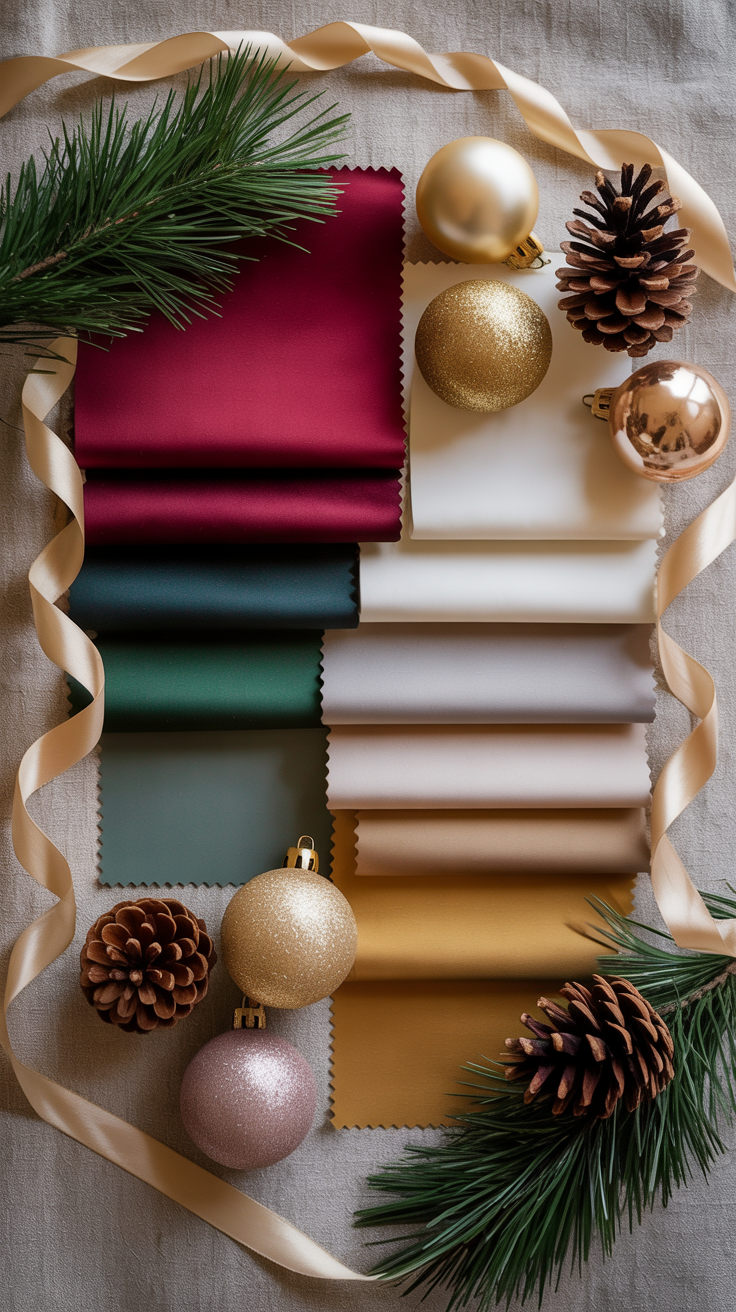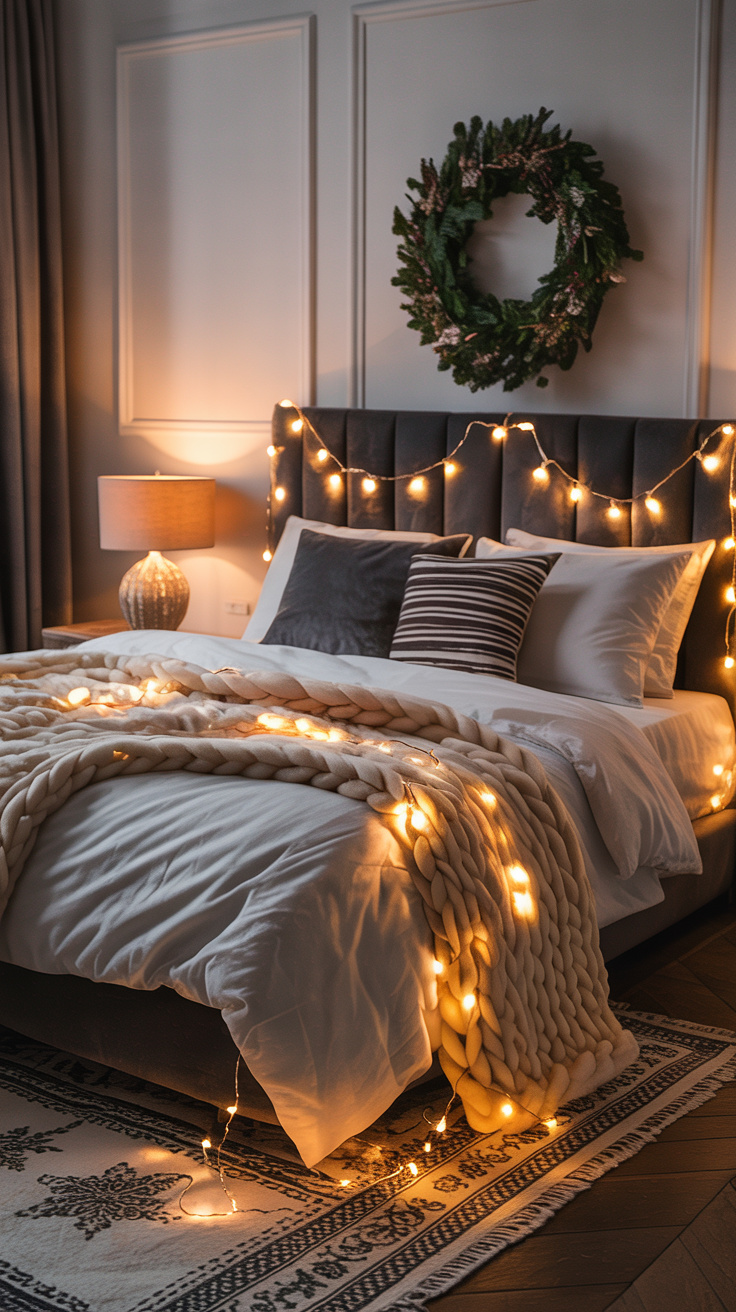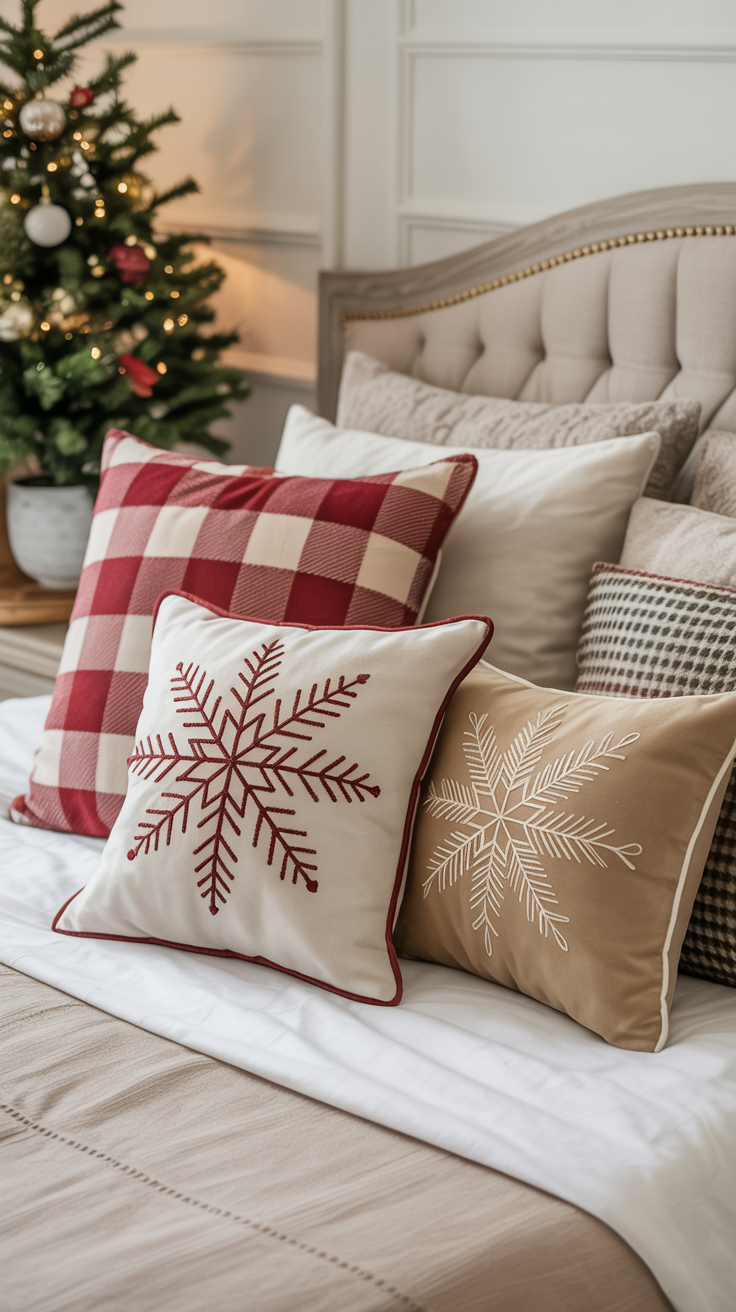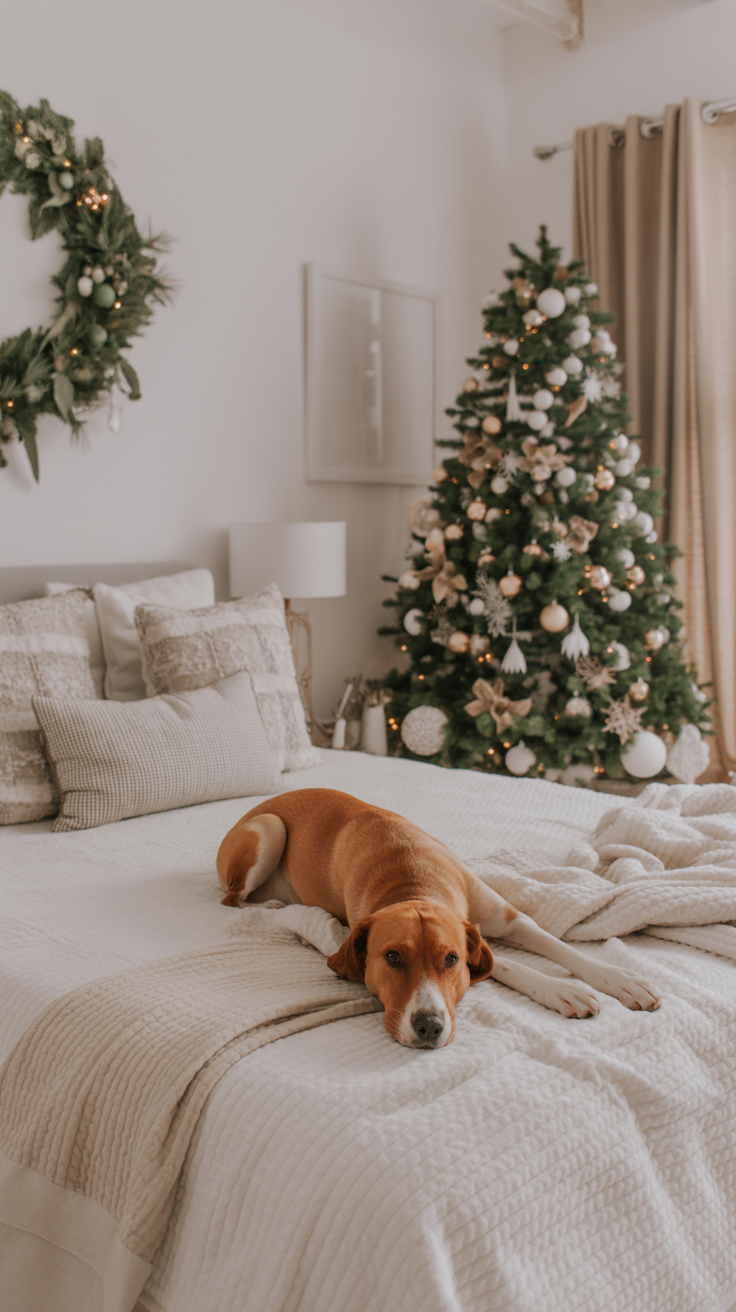A Comprehensive Guide to Creating a Festive and Cozy Christmas Bedroom
As the holiday season approaches, we often focus our decorating efforts on the main living areas of our homes—the living room, dining room, and entryway. But why not extend the festive cheer to the most personal space of all: the bedroom? Transforming your bedroom into a cozy Christmas sanctuary can be a wonderful way to unwind and embrace the magic of the season. After all, this is where you begin and end each day, and creating a space that reflects the warmth and joy of the holidays can significantly enhance your overall well-being during this special time of year.
This comprehensive guide will walk you through everything you need to know to create a festive and inviting Christmas bedroom, from choosing a color palette to adding the perfect finishing touches. Whether you have a spacious master suite or a compact bedroom, whether you’re decorating for yourself, guests, or children, you’ll find practical advice and inspiring ideas to help you create a holiday haven that feels both magical and restful.
I. The Foundation: Establishing Your Color Scheme and Theme

Before you start decorating, it’s essential to have a clear vision for your Christmas bedroom. This foundational step will help you make cohesive choices and create a space that feels both festive and serene, rather than chaotic or overwhelming.
Understanding Color Psychology in the Bedroom
The colors you choose for your Christmas bedroom decor will have a significant impact on the overall mood and atmosphere of the space. Understanding color psychology can help you create the exact ambiance you’re seeking. Traditional Christmas colors like red and green can be energizing and festive, but they need to be balanced carefully in a bedroom to avoid overstimulation. Cooler tones like blues, silvers, and whites create a calming, winter wonderland effect that can be particularly soothing for sleep. Warm metallics like gold, copper, and bronze add a touch of luxury and warmth without being too bold.
Selecting Your Color Palette
When choosing a color palette, start by considering your existing bedroom decor. The most successful Christmas decorating schemes work with, rather than against, the permanent elements of your room. If your bedroom features warm tones—creams, beiges, taupes, and warm woods—you might opt for traditional Christmas colors like deep burgundy red and forest green, accented with antique brass or copper metallics. This combination creates a rich, cozy atmosphere that feels both classic and inviting.
For bedrooms with cooler palettes featuring grays, whites, and cool-toned woods, consider a winter wonderland theme with shades of white, silver, champagne, and soft sage or ice blue. This approach creates a serene, sophisticated look that feels fresh and modern while still being unmistakably festive. Another beautiful option for any bedroom is a jewel-tone palette featuring emerald green, sapphire blue, or amethyst purple paired with metallic accents. These rich colors add depth and luxury without feeling overly traditional.
The key to success is choosing two to three main colors and using them consistently throughout your decorating scheme. This creates visual harmony and prevents the space from feeling cluttered or chaotic. One color should be dominant, while the others serve as accents that appear in smaller doses throughout the room.
Choosing a Unifying Motif
To create a cohesive look that feels intentional rather than random, choose a single motif and use it subtly throughout the room. A motif is simply a recurring decorative element that ties your design together. This could be anything from snowflakes and stars to bells, tiny houses, woodland creatures, or vintage ornaments. The key is to use the motif in a few strategic places rather than overwhelming every surface.
For example, if you choose snowflakes as your motif, you might incorporate them through a snowflake-patterned throw pillow, a piece of wall art featuring snowflakes, and a few delicate snowflake ornaments hanging in the window. This creates a sense of harmony and intentionality without making the room feel like a theme park. The motif should whisper rather than shout, adding a subtle thread of continuity that pulls the entire design together.
Creating a Mood Board
Before you begin purchasing items or decorating, consider creating a simple mood board. This can be as simple as a Pinterest board or a physical collection of paint chips, fabric swatches, and magazine clippings. Gather images that represent the feeling you want to create in your Christmas bedroom. Are you drawn to rustic, natural elements? Glamorous metallics? Cozy, cabin-inspired textures? Minimalist Scandinavian simplicity? Your mood board will serve as a reference point as you make decorating decisions, helping you stay focused and avoid impulse purchases that don’t fit your overall vision.
II. The Centerpiece: Creating a Festive Bed

The bed is the focal point of any bedroom, so it’s the perfect place to start your Christmas decorating. A beautifully dressed bed not only looks inviting but also enhances the comfort and coziness that are so essential during the winter months.
Selecting Seasonal Bedding
The foundation of your festive bed starts with the right sheets. During the Christmas season, you’ll want bedding that feels cozy and appropriate for cooler weather. Flannel sheets are a popular choice for their soft, brushed texture that provides warmth without excessive weight. They’re particularly wonderful in colder climates or for those who tend to feel chilly at night. Cotton sateen offers a silky, smooth feel with a subtle sheen that feels luxurious while still being breathable—an excellent choice for those who sleep warm or prefer a more elegant look.
When selecting the color or pattern for your sheets, think about how they’ll work with your overall color scheme. Deep ivory, mushroom gray, forest green, burgundy, or a subtle plaid can all work beautifully. If you prefer to keep your sheets neutral, you can add seasonal color through your other bedding layers. Some people enjoy having a dedicated set of Christmas sheets with festive patterns, while others prefer to keep the foundation neutral and add holiday touches through more easily changeable elements.
Layering for Luxury and Warmth
The secret to a truly inviting bed is layering. Professional designers and luxury hotels use this technique to create beds that look sumptuous and feel incredibly comfortable. Start with your fitted sheet, then add a flat sheet. Next, place a lightweight blanket—cotton, wool, or a cotton-blend—over the flat sheet. This middle layer adds warmth without excessive weight and creates that coveted “loft” that makes a bed look full and inviting.
Your duvet or comforter comes next. During the Christmas season, you might opt for a heavier weight than you use in other seasons, or choose one in a festive color that coordinates with your palette. A white or neutral duvet cover provides versatility and can be dressed up with seasonal accessories, while a colored duvet in green, burgundy, or navy makes a bolder statement.
At the foot of the bed, fold a quilt or coverlet. This adds visual interest, provides an extra layer for particularly cold nights, and creates that polished, designer look. The quilt is an excellent place to introduce pattern or an accent color from your palette. Finally, add throws. A chunky cable-knit throw or a faux fur or sherpa throw draped across the lower third of the bed adds incredible texture and invites you to curl up and get cozy. You might also drape a second, lighter throw from one corner of the bed for an effortless, lived-in look.
The Art of Pillow Arrangement

Pillows can make or break the look of your bed, and during the Christmas season, they’re an easy way to add festive touches without a major investment. The key is to think about scale, texture, and color rather than simply piling on as many pillows as possible.
Start with two European square pillows (26″ x 26″) at the back. These large pillows create height and serve as a backdrop for the rest of your pillow arrangement. You can use Euro shams in a solid color that coordinates with your palette, or choose a subtle pattern. Next, place your standard sleeping pillows in front of the Euro shams. These should be in coordinating pillowcases—either matching your sheets or in a complementary color.
Now comes the fun part: decorative accent pillows. A lumbar pillow (typically 12″ x 20″ or 14″ x 36″) adds visual interest with its rectangular shape and is the perfect place to introduce a rich texture like velvet, faux fur, or a nubby weave. Choose a color that either matches your accent color or provides a complementary contrast. Finally, add one or two smaller accent pillows that incorporate your Christmas theme. This might be a pillow with an embroidered snowflake, a festive saying, a plaid pattern, or your chosen motif. The key is restraint—one or two festive pillows create a curated look, while too many can make the bed feel cluttered and overwhelming.

Keep all of your pillows within your established color palette. Even if you’re using different textures and patterns, maintaining color cohesion will ensure that the bed looks composed and intentional rather than chaotic.
Adding a Bed Skirt or Riser
If your bed frame allows, consider adding a bed skirt in a coordinating fabric. This hides under-bed storage and gives the bed a finished, polished look. During the Christmas season, you might choose a bed skirt in a festive color or a subtle pattern. Alternatively, if your bed sits low to the ground and you’d like to create more visual impact, bed risers can add a few inches of height, making the bed feel more substantial and creating additional storage space underneath.
III. Beyond the Bed: Decorating Walls and Windows
Once your bed is beautifully dressed, it’s time to turn your attention to the walls and windows. These elements frame your space and provide excellent opportunities to reinforce your Christmas theme.
The Wall Above Your Bed
The wall above your bed is prime real estate for a festive focal point. This is often the first thing you see when you enter the room, so it deserves special attention. A wreath is a classic choice that works in almost any style of bedroom. For a traditional look, choose an evergreen wreath with pinecones and berries. For a more modern aesthetic, consider a minimalist wreath made from eucalyptus or a geometric wreath form decorated with simple ornaments.
When hanging a wreath above your bed, use a long ribbon so the wreath hangs at a height that relates to the bed rather than floating awkwardly in empty space. The bottom of the wreath should typically be about 6-12 inches above the top of your headboard or pillows. If you don’t have a headboard, aim for the wreath to hang at approximately the same height as if you did.
Another beautiful option is a garland. A slim, elegant garland can be mounted directly to the wall (using removable hooks to avoid damage) and draped in a gentle arc above the bed. Weave in a ribbon that echoes one of your accent colors, and consider adding small battery-operated lights for a soft glow. The key with garlands is to keep them slim and elegant—you don’t want them to look heavy or to interfere with your pillows.
Seasonal Art and Wall Decor
If wreaths and garlands aren’t your style, consider swapping out your regular wall art for something seasonal. A winter landscape photograph, an abstract painting in your Christmas colors, a vintage holiday poster, or even a simple framed print with a festive saying can all work beautifully. The advantage of this approach is that it feels sophisticated and can be as subtle or as bold as you prefer.
For a more creative approach, you might create a small gallery wall of Christmas-themed prints, family holiday photos in coordinating frames, or a collection of vintage Christmas cards. Keep the frames consistent in color (all white, all gold, all black, or all natural wood) to maintain a cohesive look even with varied artwork.
Window Treatments That Enhance the Season
Your windows offer another excellent opportunity to add festive touches while also serving the practical purpose of insulation and privacy during the darker winter months. Consider swapping out your lightweight summer curtains for heavier drapes in a rich fabric like velvet, linen, or a wool blend. These fabrics not only look luxurious but also help insulate your room against winter drafts.
Choose a color that ties into your overall palette. Deep green velvet curtains can look incredibly elegant and festive, while cream or gray linen provides a neutral backdrop that allows your other decorations to shine. If you love pattern, a subtle plaid, a winter botanical print, or a geometric design can add visual interest without overwhelming the space.
The way you hang your curtains also matters. For a more luxurious look, hang your curtain rod higher than the top of your window frame—ideally close to the ceiling—and choose curtains that puddle slightly on the floor or just kiss it. This creates the illusion of taller windows and a more elegant space.
Decorating the Windowsill
Your windowsill is a perfect spot for a small seasonal vignette. The key is to keep it simple and sculptural so you don’t block natural light or make the window feel cluttered. A trio of bottlebrush trees in graduated heights creates a charming winter forest scene. You might choose traditional green trees, or opt for white or silver for a more modern look.
Other beautiful windowsill options include a single ceramic or wooden house (perhaps one that lights up from within), a shallow bowl filled with clementines and bay leaves for a natural, fragrant display, a collection of white candles in varying heights, or a simple arrangement of winter branches in a small vase. At night, a strand of micro LED lights woven along the windowsill transforms the window into a gentle, glowing focal point that’s visible from both inside and outside your home.
If you have a window seat, dress it for the season with festive cushions and a cozy throw. This creates an inviting spot for reading, daydreaming, or simply enjoying the winter view.
IV. The Magic of Light: Creating a Warm and Inviting Ambiance
Lighting is perhaps the most important element in creating a cozy and inviting atmosphere in your Christmas bedroom. The right lighting can transform an ordinary space into a magical retreat, while poor lighting can undermine even the most beautiful decorations.
Understanding Layered Lighting

Professional designers rely on a concept called “layered lighting,” which involves using multiple light sources at different heights and intensities to create depth, warmth, and flexibility. In a bedroom, this typically includes ambient lighting (overhead fixtures), task lighting (reading lamps), and accent lighting (decorative lights that highlight specific features or create mood).
During the Christmas season, you’ll want to emphasize warm, gentle lighting that creates a cozy atmosphere. This means relying less on harsh overhead lights and more on lamps, string lights, and candles. The goal is to create a soft, diffused glow that feels welcoming and relaxing rather than bright and energizing.
Choosing the Right Bulbs
The color temperature of your light bulbs makes an enormous difference in the ambiance of your room. Light bulbs are measured in Kelvins (K), with lower numbers producing warmer, more yellow light and higher numbers producing cooler, more blue light. For a cozy Christmas bedroom, look for bulbs in the 2700K to 3000K range, often labeled as “warm white” or “soft white.” These bulbs produce a gentle, golden glow that feels intimate and relaxing.
Avoid bulbs labeled “daylight” or “cool white” (typically 5000K or higher) in your bedroom, as these produce a harsh, blue-toned light that can feel clinical and is not conducive to relaxation or sleep. If you’re using dimmable fixtures, invest in quality dimmable LED bulbs, which allow you to adjust the light level throughout the evening as you wind down.
Bedside Lighting
Your bedside lamps are essential for both function and ambiance. If you read in bed, make sure your bedside lamps provide adequate light for this purpose—you may need a lamp with a three-way bulb or a dimmer switch so you can have brighter light for reading and softer light for ambiance. The lampshade material also affects the quality of light: linen or fabric shades create a soft, diffused glow, while metal shades direct light more specifically and create a moodier effect.
For a festive touch, you might wrap a strand of fairy lights around the base of your lamp, tie a ribbon around the lampshade, or simply switch to a lampshade in a seasonal color. If your nightstands are crowded, consider installing wall-mounted sconces, which free up surface space while still providing necessary light. Adjustable arm sconces are particularly useful for reading.
String Lights and Fairy Lights
String lights are synonymous with Christmas, and they can be used beautifully in the bedroom to create a magical, twinkling effect. The key is to use them thoughtfully rather than haphazardly. Micro LED lights with thin, nearly invisible wires create the most elegant effect. You can weave them through a garland above your bed, drape them along your headboard, arrange them in a glass jar or vase on your dresser, hang them vertically from your curtain rod for a “light curtain” effect, or create a canopy effect by hanging them from the ceiling above your bed.
When using string lights in the bedroom, opt for warm white rather than multicolored lights for a more sophisticated look. Battery-operated lights are convenient for areas without nearby outlets, and many now come with timers so they automatically turn on and off at set times.
Candles and Flameless Options
Candles add both light and ambiance to a Christmas bedroom, but safety is paramount. In the bedroom, it’s wise to use flameless LED candles on surfaces within reach, such as nightstands, and reserve real candles for higher, stable surfaces like dressers, mantels, or high shelves where they’re less likely to be knocked over.
Modern flameless candles have come a long way and can look remarkably realistic, especially those made with real wax and featuring a flickering LED “flame.” Many come with remote controls and timers, allowing you to set them to turn on automatically each evening. Arrange candles in groups of varying heights for visual interest, and consider placing them on a decorative tray or mirror to amplify their glow.
If you do use real candles, never leave them unattended, and always extinguish them before falling asleep. Opt for unscented candles in the bedroom, or choose very subtle scents, as strong fragrances can be overwhelming in a sleeping space.
Creating a Lighting Routine
One of the most effective ways to use lighting in your Christmas bedroom is to create an evening routine that signals to your body and mind that it’s time to wind down. About an hour before bed, turn off overhead lights and rely solely on your lamps and decorative lights. Thirty minutes before bed, dim your lamps or turn off all but one small light source. This gradual reduction in light helps prepare your body for sleep while allowing you to enjoy the cozy, magical atmosphere you’ve created.
V. The Finishing Touches: Details That Bring Joy
It’s often said that God is in the details, and this is certainly true when it comes to creating a beautiful Christmas bedroom. The small, thoughtful touches you add will elevate your space from simply decorated to truly special.
Nightstand Styling

Your nightstands are functional necessities, but they can also be beautiful. The key to styling a nightstand for Christmas is to keep it practical while adding a few festive touches. Start with a small tray, which instantly creates a sense of order and intention. On the tray, place your lamp, a small dish for jewelry or other small items, and one decorative object that ties into your Christmas theme—perhaps a small ceramic tree, a decorative bell, a miniature house, or a small arrangement of winter greenery.
If you enjoy fragrance, a small reed diffuser with a subtle seasonal scent like cedar, vanilla, or pine can be lovely. Just be sure the scent isn’t too strong, as overpowering fragrances can interfere with sleep. Leave enough open space on your nightstand for essentials like your phone, a glass of water, or a book. The goal is to create a surface that’s both beautiful and functional.
Incorporating Natural Elements
Bringing natural elements into your Christmas bedroom creates a connection to the outdoors and adds organic texture that balances the more polished elements of your decor. Winter branches—whether evergreen, birch, or bare branches—can be arranged in a tall vase to create a striking vertical element. Pinecones arranged in a bowl or scattered on a tray add a rustic touch and can be left natural or painted gold or white for a more refined look.
Fresh greenery like cedar, pine, or eucalyptus not only looks beautiful but also adds a wonderful natural fragrance to your room. A small arrangement on your dresser or nightstand can last for weeks and will fill your room with the scent of the season. If you prefer a longer-lasting option, high-quality faux greenery has become remarkably realistic and can be used year after year.
Other natural elements to consider include a bowl of seasonal fruit like clementines or pomegranates, which add color and can be refreshed as needed; cinnamon sticks tied with ribbon; or a collection of white or cream-colored stones or shells arranged in a shallow dish for a winter beach aesthetic.
The Power of Scent
Scent is one of the most powerful ways to evoke emotion and create atmosphere, and the right fragrance can make your Christmas bedroom feel truly special. The key in a bedroom is to choose scents that are pleasant but not overwhelming, as you’ll be spending extended periods in this space, including sleeping.
Classic Christmas scents include pine, cedar, cinnamon, vanilla, orange, and clove. However, some of these—particularly cinnamon and clove—can be quite strong and may be better suited to common areas rather than bedrooms. For the bedroom, consider gentler options like vanilla and cedar, orange and evergreen, or lavender with a hint of eucalyptus for a calming effect.
Reed diffusers are ideal for bedrooms because they provide constant, subtle fragrance without requiring an open flame. Essential oil diffusers are another excellent option, allowing you to customize your scent and control the intensity. If you prefer candles, choose those with subtle fragrances and burn them for short periods rather than all evening.
Whatever scent method you choose, use only one fragrance in your bedroom rather than mixing multiple scents, which can become overwhelming and create sensory confusion.
Adding a Christmas Tree to Your Bedroom
A Christmas tree in the bedroom might seem extravagant, but it can be one of the most magical additions to your holiday decor. The key is choosing the right size and style for your space. If you have floor space available, a slender tree placed near a window or in a corner can work beautifully. Choose a tree that’s proportional to your room—typically no taller than 4-6 feet in a standard bedroom.
For smaller spaces, a tabletop tree on your dresser, a side table, or a plant stand can provide all the charm of a full-sized tree without taking up valuable floor space. Tabletop trees typically range from 18 inches to 3 feet tall and can be surprisingly impactful when decorated thoughtfully.
When decorating a bedroom tree, restraint is key. Choose a simple color palette—perhaps just white and silver, or natural wood ornaments, or a single color of matte ornaments. Avoid the temptation to cover every branch. Instead, place ornaments thoughtfully, allowing the tree’s natural shape to show through. Warm white lights tucked deep within the branches create a soft glow without being too bright for a sleeping space.
For the tree base, skip the traditional tree skirt and opt for something more refined like a woven basket, a metal stand in a finish that coordinates with your decor, or a simple collar made from fabric or woven materials. This creates a more sophisticated, bedroom-appropriate look.
Dresser and Mirror Decor
Your dresser provides another surface for festive styling. Create a simple vignette using a tray as a foundation. Add a small vase with winter stems or greenery, a decorative object that echoes your motif, and perhaps a small candle or two. You might also include a small framed photo, a vintage Christmas card in a stand, or a decorative box for storing jewelry or small items.
If you have a mirror above your dresser, you can decorate it subtly by draping a ribbon from the top with a small ornament or bell attached, or by tucking a slim garland along the top edge. Mirrors reflect light, so any decorative lighting near your mirror will have double the impact. Be careful not to obscure the mirror’s function—you should still be able to use it easily.
Creating a Reading Nook
If space allows, a cozy reading nook can be a wonderful addition to your Christmas bedroom. A comfortable chair positioned near a window or in a corner, paired with a small side table and a good reading lamp, creates an inviting spot for quiet moments. Dress the chair with a festive throw and a decorative pillow. On the side table, place your current read, a cup of tea, and perhaps a small decorative object.
If you don’t have room for a chair, you can create a mini reading nook by placing a couple of floor cushions near a window with a folded blanket and a basket of books nearby. The key is creating a designated spot that invites you to slow down and savor the season.
Sound and Music
Don’t forget the role of sound in creating atmosphere. A carefully curated Christmas playlist can enhance the ambiance of your bedroom. Choose music that’s calming rather than energizing—soft instrumental carols, classical Christmas music, or gentle jazz interpretations of holiday favorites. Keep the volume low so the music serves as a pleasant background rather than a focal point.
If you enjoy ambient sounds, consider a recording of a crackling fireplace, gentle snowfall, or winter wind. These sounds can be particularly soothing as you’re falling asleep and can help mask any disruptive noises from outside your room.
VI. Decorating for Different Spaces and Situations
No matter the size of your bedroom or who you share it with, you can create a festive and inviting space for the holidays. Here are specific strategies for different situations.
Small Bedrooms: Maximizing Impact in Minimal Space
If you have a small bedroom, you might think you don’t have room for Christmas decorations, but this simply isn’t true. Small spaces can be incredibly charming when decorated thoughtfully. The key is to focus on vertical space and to choose decorations that serve multiple purposes.
Hang a wreath above your bed to draw the eye upward and create a focal point without using any floor space. Use wall-mounted sconces instead of table lamps to free up your nightstands. Add a narrow floating shelf near the door or above your dresser to display a few small decorative items—a trio of bottle brush trees, a small ceramic house, or a collection of ornaments in a glass jar.
Choose a slender, vertical Christmas tree rather than a full, wide one. A pencil tree can fit in surprisingly tight spaces and still provide the magic of a Christmas tree. Alternatively, a tabletop tree on your dresser or a wall-mounted tree made from lights or garland can provide festive cheer without using precious floor space.
Mirrors are your friend in small spaces. A large mirror not only makes the room feel bigger but also reflects your Christmas lights and decorations, amplifying their impact. Keep your color palette simple and cohesive—too many colors in a small space can feel chaotic. Stick to two or three colors and use them consistently throughout your decorations.
Finally, embrace the concept of “less is more.” In a small bedroom, one beautifully decorated focal point—whether it’s your bed, a small tree, or a decorated window—will have more impact than trying to decorate every surface. Choose quality over quantity, and let each piece you include really shine.
Guest Bedrooms: Creating a Welcoming Holiday Retreat

If you’re hosting guests during the Christmas season, transforming your guest bedroom into a festive retreat is a wonderful way to make them feel welcome and special. Start with the bed, ensuring it’s made with fresh, comfortable linens. Layer on extra blankets and throws so guests can adjust their warmth level according to their preferences. Include pillows of varying firmness so guests can choose what’s most comfortable for them.
Add festive touches that feel welcoming rather than overwhelming. A small tabletop Christmas tree on the dresser, a wreath on the wall, or a garland along the windowsill adds holiday cheer without making the room feel cluttered. Fresh greenery in a vase or a small arrangement of winter branches brings life to the space and adds a pleasant natural fragrance.
Create a welcome tray on the dresser or nightstand with thoughtful amenities: a carafe of water and glasses, a small plate of cookies or chocolates, a candle, and a card with the Wi-Fi password and any other information your guests might need. You might also include a basket with extra toiletries, a selection of teas or hot chocolate packets, and perhaps a small book or magazine for bedtime reading.
Make sure the room has adequate lighting with lamps on both sides of the bed if possible. Include a few festive touches like a holiday-scented diffuser (with a subtle scent), cozy slippers in a basket, and extra hangers in the closet. These small details show your guests that you’ve thought about their comfort and want them to feel at home.
Kids’ and Teens’ Rooms: Balancing Fun and Function
When decorating a child’s or teenager’s room for Christmas, it’s important to create a space that’s both festive and conducive to sleep. Children can become overstimulated by too much visual input, which can actually interfere with their ability to settle down at bedtime.
Start by involving them in the process. Let them help choose a color scheme or motif for their room. This gives them ownership of the space and ensures the decorations reflect their personality and preferences. For younger children, a small Christmas tree in their room can be magical. Let them help decorate it with unbreakable ornaments, and consider making it a tradition to add one special ornament each year that commemorates something significant from that year.
Keep the decorations playful but not overwhelming. A few festive pillows, a holiday-themed throw blanket, and some simple wall decorations like paper snowflakes or a garland can create a festive atmosphere without overstimulating. String lights can be wonderful in a child’s room, but make sure they’re on a timer so they turn off at bedtime rather than staying on all night, which can interfere with sleep quality.
For teenagers, take a more sophisticated approach. They may appreciate a color scheme that’s less traditionally Christmas and more aligned with their personal style—perhaps silver and blue, or white and gold. A small tree, some decorative lights, and a few carefully chosen accessories can make their space feel special without feeling childish. Respect their growing independence by asking for their input and avoiding anything that feels too juvenile.
Consider creating a special Christmas tradition for their room, such as an advent calendar with small gifts or notes, a jar where they can write down favorite memories from each day of December, or a special ornament that they choose each year to add to their personal collection.
Pet-Friendly Decorating: Safety and Style

If you share your bedroom with furry friends, you’ll need to take some extra precautions to ensure your Christmas decorations are safe for them. The good news is that with a few adjustments, you can still create a beautiful, festive space that’s safe for your pets.
Start by securing any Christmas tree to the wall or ceiling to prevent it from tipping over if your pet decides to investigate or play with it. Place fragile ornaments higher on the tree, out of reach of curious paws or wagging tails. Use felt, wood, or unbreakable ornaments on the lower branches. Avoid tinsel entirely, as it can be extremely dangerous if ingested by cats or dogs.
Use museum putty or adhesive to secure decorative items on low surfaces like nightstands or dressers. This prevents them from being knocked over by a curious cat or an enthusiastic tail wag. Be cautious with candles, keeping them on high surfaces where they can’t be reached or knocked over. Flameless candles are a safer option when you have pets.
Avoid decorations with small parts that could be chewed off and swallowed, and be cautious with plants like poinsettias, holly, and mistletoe, which can be toxic to pets. If you want to include greenery, research pet-safe options or use high-quality artificial alternatives placed out of reach.
Consider your pet’s favorite spots in your bedroom and work with them rather than against them. If your dog loves to sleep on the bench at the foot of your bed, make it extra cozy with a washable throw in a festive color. If your cat likes to perch on your dresser, leave that space relatively clear rather than filling it with decorations that will inevitably be knocked off.
With thoughtful planning, you can create a Christmas bedroom that’s beautiful, festive, and safe for every member of your family, including the four-legged ones.
Conclusion: Creating Your Personal Christmas Sanctuary
Creating a festive and cozy Christmas bedroom is about more than just adding decorations—it’s about crafting a personal sanctuary where you can retreat from the busyness of the holiday season and reconnect with the peace and joy that this time of year should bring. By thoughtfully considering your color palette, layering textures and lighting, and adding meaningful details, you can transform your bedroom into a space that nurtures your well-being and celebrates the magic of Christmas.
Remember that the most successful Christmas bedroom is one that reflects your personal style and meets your specific needs. There’s no single right way to decorate—what matters is that your space feels welcoming, comfortable, and joyful to you. Whether you prefer a traditional red and green scheme or a modern minimalist approach, whether you fill your room with decorations or add just a few subtle touches, the goal is the same: to create a space where you can rest, recharge, and savor the special atmosphere of the holiday season.
As you implement the ideas in this guide, give yourself permission to experiment and adjust. If something doesn’t feel right, change it. If you discover you love a particular element, expand on it. Your bedroom should evolve throughout the season as you discover what brings you the most joy and comfort.
Finally, remember that the true magic of Christmas isn’t in the decorations themselves, but in the feelings they evoke and the memories they help create. A beautifully decorated Christmas bedroom is simply a backdrop for the real treasures of the season: peaceful mornings, cozy evenings, quiet moments of reflection, and the simple pleasure of being in a space that feels like home. May your Christmas bedroom bring you comfort, joy, and countless happy memories this holiday season and for many years to come.



